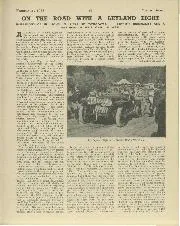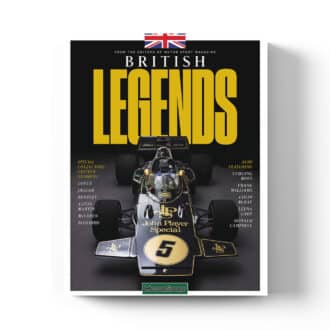
ON THE ROAD WITH A LEYLAND EIGHT
ON THE ROAD WITH A LEYLAND EIGHT IMPRESSIONS OF SIR LIONEL PHILLIPS'S 1927 TWO-SEATER. EXTREME ORIGINALITY AND A MAXIMUM OF WELL OVER 100 M.P.H. ALTHOUGH the Leyland Eight was discontinued…
TRYING OUT THE TYPE 55 BUGATT1
A COMFORTABLE NEW SPORTS MODEL, WHICH COMBINES TOURING AND RACING CAR CHARACTERISTICS.
W” E have heard often enough that the racing car of yesterday is the sports car of to-day. In no car is this better exemplified than in the new double-camshaft 2.3 litre Super Sports Bugatti, on which we recently had a short but nevertheless exhilarating trial run.
The engine and chassis are the same as those used in the 2.3 litre Grand Prix model, with a lower compression which allows the Type 55 to run on ordinary fuel. The same chassis is also used on the 4.9 Super-Sports and Grand Prix models, though with larger wheels and tyres, so that most of the following details apply to the whole range of sports and competition models. The engine is, of course, a straight eight, with bore
a and stroke of 60 and 100 mm respectively, giving a capacity of 2,270 c.c. Alloy pistons are used, with the special Bugatti connecting rods which taper towards the little end, and are strengthened by a rib on each side. Two overhead camshafts are fitted, driven by a vertical shaft in the front of the engine. The camshafts are carried in nine bearings, and operate the two valves per cylinder,— which are inclined to one another at about 90 degrees— directly through steel pistons. Each cylinder has one sparking plug, which is carried midway between the two valves.
Roller bearing big ends.
A five bearing crankshaft is used, the centre bearing and the two outers being ball races, and the other two rollers. Roller bearing big ends are employed.
On the near side of the engine is mounted a water pump driven by skew gears from the crankshaft, while the dynamo is driven direct from the front end of the engine. The Roots type supercharger is fitted on the off side, and is driven from the front end of the crankshaft through a train of gears and a shaft with a flexible coupling. The carburettor, which is bolted to the bottom of the blower, comes below the level of the side members, but is easily reached by removing a special cover.
Wet sump lubrication is employed, the oil passing through a filter on its way to the sump, and is pumped to the bearings through another pressure-type filter, situated on the side of the crank case between the exhaust pipes and easily removed for cleaning. The sump holds 1+ gallons, a further gallon being carried in a tank under the passenger’s seat, whence it can be pumped into the sump. 22 gallons of petrol is carried in the rear tank.
In accordance with the usual Bugatti practice, the magneto is driven from one of the camshafts, the contact-breaker cover actually projecting through the dash, and allowing of ready inspection. The other camshaft operates the A.C. petrol pump, and the rev, counter drive is also taken from it. The compression ratio is not given, but as the car runs without pinking on a mixture of two thirds petrol and one third benzol, it is probably about 6.5 to 1 at full revs The drive is transmitted through a multiple-disc clutch and a short shaft with two universal joints to a four-speed gearbox, which is provided with central ball change, thence by open propellor
shaft to a straight bevel back axle. Torque is taken by a member running alongside the propellor shaft, and two other radius tubes from the spring mountings to the chassis further relieve the springs of any loads except the weight of the car.
The back-axle ratio is 3.6 to 1, but for some reason the factory does not publish the gear-box reductions. As far as one could tell from comparing speedometer and rev. counter readings, they are approximately 4.32, 6.56 and 9.4 to 1, which give at 5,000 r.p.m. speeds of 42, 63,95 and 114 m.p.hb respectively. 5,000 r.p.m. is the maximum advised, but another 500 or so for a short time would not do any damage. The chassis is slightly upswept to clear the
front axle, then is almost horizontal as far as the back axle, where it is again upswept. The front springs are semielliptic, passing through the solid front axle, while the rear ones are the reversed quarter elliptic which have long proved so successful on Bugatti cars. The brakes, which operate on 15 inch drums, are cableoperated and are compensated by the familiar chain and sprocket gear. The steel brake drums are actually carried in the cast aluminium wheels, so that the shoes are immediately accessible on removing the wheels.
The type 55 chassis is fitted with 19″ by 5′ racing Dunlop tyres, and the wheels are secured to Rudge hubs by the distinctive Bugatti knock-on caps.
The car we tested was fitted with a smart and comfortable two-seater body finished in black and red, with a large luggage compartment at the rear. Pneumatic upholstery was installed, and the whole car. was a great advance on the rather spartan bodies which were traditional on the faster Bugattis. On first getting into the car, our first thought was the comfort of the front seat, and our second the possibility of being catapulted over the low-cut side of the body. Familiarity soon bred confidence, and we found it possible to make intelligible notes when the car was doing
Tractability.
The streets of South London presented their usual crowded appearance, and provided a good test of the ” 2.3 “s tractibility. The exhaust note is subdued, and in top gear one hears nothing more than a pleasant hum. Changing down to accelerate, one caught a suggestion of the real character of the car, the blower and its gears making a most stimulating sound
which can be only rendered as ” hurraa-a-,” a remark with which we entirely agreed.
On gaining the open road, the shockabsorbers, which are adjusted on the Andre Telecontrol system by two handwheels on the dash, Were tightened, and acceleration figures were taken. These are qiiite phenomenal, but rather than indulge in superlatives we prefer to refer readers to the graph. Unfortunately these figures can only be approximate, owing to the delayed action of the J aegar speedometer and rev, counter, but any error does not favour the car. For anything except acceleration figures, the steadiness of the needles far outweighs the slight interval which occurs between readings.
The braking figure of 57 feet from 37.5 m.p.h. (60 km.), does not seem in keeping With the rest of the car’s performance. Either the linings were not properly bedded in, or were of unsuitable material. 15 inch brake drums being provided, the fault is obviously not in the installation. In operation the brakes were excellent, the car continuing in a straight line no matter how hard they were applied.
These preliminaries finished, we were able to get on with the all-too-short road test. In the new 2.3 the driving position is much more upright than in the average sports car, deep yells being provided on each side of the propellor shaft. The steering wheel Comes right into one’s lap, with the gear lever, brake, gear and ignition control under the left hand. A sloping windscreen does its work effectively, and altogether the car is perfection to drive. The crowded state of the roads made it inadvisable to exceed 100 m.p.h., -although we were told that at 5.30 one morning the speedometer did creep round to 112 At speeds above about 80 the sound of the blower and its gears rises above audibility, and one glides along as in a fast aeroplane, with no sound but the rushing wind. Cornering, of course, is effortless, and if a bend is taken too fast, the car seems to correct the error without
correct the error without help from the driver. The steering was light, firm, and had ample caster. There is no gainsaying the fact that only firms with racing experience can get Such a combination, which is a model that
English manufacturers might well follow. The gearchange requires considerable practice before one gets the knack of it. The clutch pedal operates in a forward instead of a more or less vertical direction, while the change from top to third is so quick that the lever can be pushed right across at 60 m.p.h. When these points are realised, the change becomes reasonably simple, and the colossal acceleration on the indirect gears can be used. Actually third and top can be used in most cases, even in traffic, and by slightly retarding the ignition, the car runs down to 700 r.p.m. on top gear
Comparing the car with the Type 43 single camshaft model which was tested M the May, 1930 issue of MOTOR SPORT, the principal difference is not in the maximum Speed but in the acceleration. The Type 43 took about 45 seconds to reach 86 from a standing start, while the Type 55 reaches this figure in about 20. seconds from 15 m.p.h. Allowing for the normal four-seater body and the standing start in the case of the Type 43, the performance of the new car is still about twice as good as the earlier mie.
The advance in comfort and ease of upkeep is just as great. The seats are Comfortable, the car starts readily and. can be run on Champion Rls even when warming up, and the exhaust note and the appearance do not attract unwelcome attention from the police. The car in fact is the complete dual purpose vehicle.
This combination Seems at present beyond the capabilities of British manufacturers, but one hopes that the institution of road-racing in England will produce some day a car with a Continental performance. We returned the car with sincere regrets that we only had put in 50 instcad of 500 miles. The price of the car with twoseater body is £1,350, and it is available
for inspection and demonstration at Ettore Bugatti Automobiles, I, Brixton Road, London, S.W.9.



